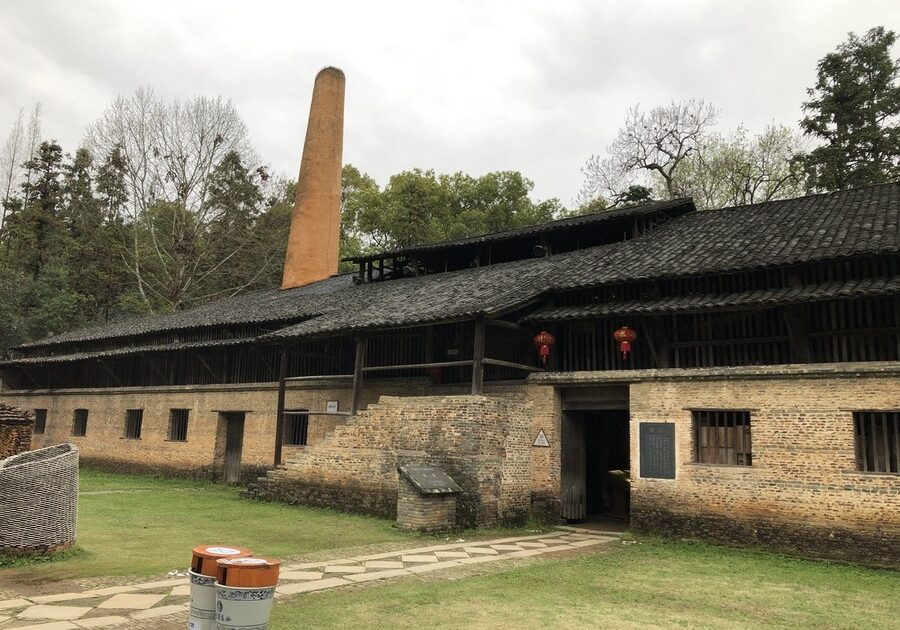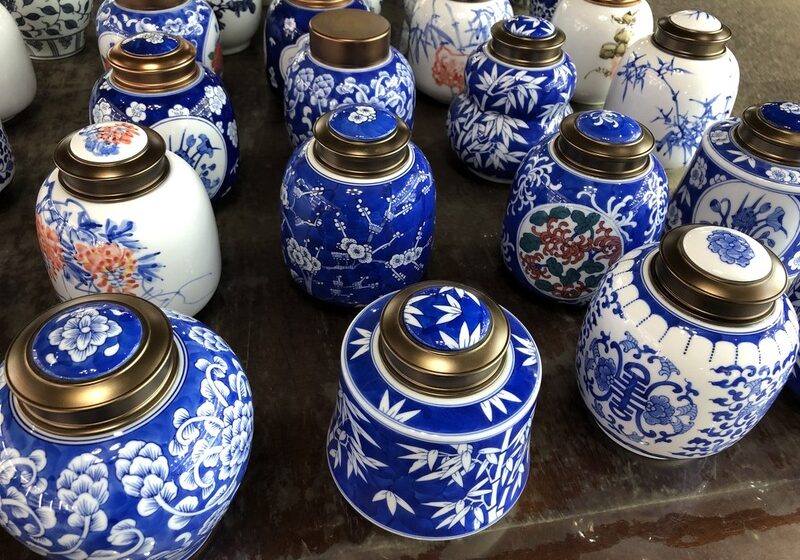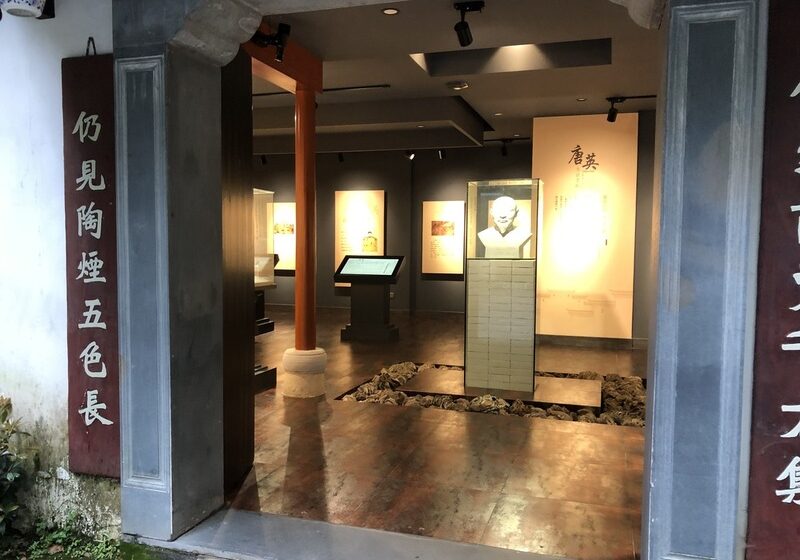Welcome to
The Jingdezhen Museum of Ancient Kiln and Folk Customs, an expansive cultural destination on Panlong Hill, Jingdezhen, China. Spanning 83 hectares, this museum seamlessly integrates captivating exhibitions, immersive ceramic experiences, and enjoyable entertainment. As China's sole national-level tourist attraction centered around ceramic culture, it holds immense significance. Explore the exhibition area showcasing ancient kilns and relics, delve into the rich heritage and customs associated with ceramics, and find leisure and delight in the waterfront street creative leisure area. Recognized as a "National 5A Tourist Attraction," our museum invites you to discover the beauty and heritage of ceramic culture.
The Ancient Kiln and Folk Customs Museum in Jingdezhen boasts a well-organized layout, divided into four major regions that offer distinct and captivating experiences for visitors.
Jingdezhen Ancient Kiln and Folk Custom Museum
Main Attractions of the Jingdezhen Museum of Ancient Kiln and Folk Customs
The Steamed Bun Kiln, named for its resemblance to a steamed bun (mantou), is a remarkable example of kiln design used during the Song, Yuan, and Ming periods in Jingdezhen. Some variations of this kiln feature a distinctive horseshoe-shaped kiln bed, earning them the name Horseshoe-shaped Kilns.
Belonging to the semi-downdraft kiln type, the Mantou Kiln exhibits a unique firing process. Flames erupt from the firebox, gracefully ascending towards the kiln roof before descending to the kiln bed. The resulting heat and smoke are expelled through a system of flues, vertical flues, and chimneys. This carefully engineered design allows the Mantou Kiln to reach astounding temperatures of up to 1300 degrees Celsius, creating an environment of reduction.
The Steamed Bun Kiln stands as a testament to the ingenuity and craftsmanship of the Yuan Dynasty potters in Jingdezhen. Its distinct shape and firing techniques were integral to the production of high-quality ceramics during this era. The ability to achieve a reduction atmosphere within the kiln played a crucial role in enhancing the glazes and colors of the pottery, resulting in exquisite pieces that are highly prized to this day.
Visiting the Steamed Bun Kiln offers a unique opportunity to witness the historical significance and technological advancements of ceramic firing techniques. It provides a glimpse into the artistry and innovation that characterized Jingdezhen's kiln industry during the Yuan Dynasty.
The Dragon Kiln stands as a testament to the rich heritage of traditional ceramic kilns in China. Named for its dragon-like shape, this kiln holds a significant place in the history of Jingdezhen's ceramic industry. Built on a sloping hillside, it showcases a simple yet effective structure, consisting of the kiln head, kiln bed, and kiln tail.
One of the notable features of the Dragon Kiln is its fuel source, which commonly includes thatch and branches. This choice of materials allows for cost-effective construction and provides ample loading capacity. Additionally, the design takes advantage of residual heat, maximizing its utilization. Nestled on natural slopes, the Dragon Kiln harnesses the power of a strong draught, creating an optimal reduction atmosphere for firing celadon and yingqing ceramics.
During the Song Dynasty, the Dragon Kiln played a pivotal role in the flourishing ceramic industry of Jingdezhen. Its efficient firing process and ability to produce high-quality ceramics contributed to the city's reputation as a center of ceramic excellence. Today, remnants of Dragon Kilns from the Song Dynasty can still be found in various locations such as Hutian, Yaoli, and Liyang in Jingdezhen, serving as a testament to its enduring legacy.
Exploring the Dragon Kiln offers a unique opportunity to delve into the ancient techniques and craftsmanship that defined Jingdezhen's ceramic production during the Song Dynasty. Witness the ingenuity of its design and the remarkable firing capabilities that shaped the creation of exquisite celadon and yingqing ceramics.
The Hulu Kiln, also known as the gourd-shaped wood-fired kiln, holds a unique place in the ceramics history of Jingdezhen. Emerging in the late Yuan and early Ming Dynasty, it gradually gave way to the egg-shaped kilns (Zhen Kiln) during the early Qing Dynasty. Notably, the Hulu Kiln is mentioned and illustrated in Song Yingxing's "Tiangong Kaiwu," a comprehensive record of technology during that time.
During the Ming Dynasty, the Hulu Kiln showcased a fusion of the Dragon Kiln and the Mantou Kiln from the Song and Yuan periods, incorporating their respective advantages. This innovative approach marked significant progress in firing techniques and made remarkable contributions to the development of Jingdezhen's porcelain industry throughout the entire Ming Dynasty. It also played a crucial role in shaping the formation of the renowned Zhen Kiln during the Qing Dynasty.
Exploring the legacy of the Hulu Kiln offers a captivating journey into the advancements and achievements of Jingdezhen's ceramics industry during the Ming Dynasty.
The Zhen Kiln of the Qing Dynasty stands as a remarkable example of traditional ceramic kilns in China, boasting a distinctive and unique style. Its kiln house is a wooden structure designed in a captivating "piercing and entertaining" architectural style. Stretching approximately 15-20 meters in length, with a capacity of around 300 cubic meters and reaching a height of about 6 meters at its highest point, it captivates the imagination.
Fueled by pine wood, the Zhen Kiln is often referred to as the "firewood kiln." Its firing process exhibits long flames with low ash content and devoid of harmful substances. This ideal environment lends itself to reduction firing, creating captivating color effects on white porcelain, blue and white porcelain, and glazed surfaces. The Zhen Kiln's ability to produce exceptional color nuances and intricate designs further cements its significance in the ceramic world.
Preserving its historical importance, the Zhen Kiln is recognized as the most complete and valuable ancient ceramic kiln that has endured to this day. Its preservation showcases the dedication to cultural heritage and craftsmanship. On July 25, 2000, the Zhen Kiln was officially declared a provincial-level key cultural relic protection unit by the People's Government of Jiangxi Province, highlighting its status as an invaluable cultural treasure.
Visiting the Zhen Kiln offers a glimpse into the sophisticated firing techniques and artistic mastery of the Qing Dynasty.
The Lion Kiln, named for its resemblance to a majestic lion, emerged as a popular kiln style during the Qing Dynasty and the Republic of China era. While most kilns of that time relied on burning pine firewood as fuel, the Lion Kiln set itself apart by utilizing pine branches and miscellaneous wood, known locally as "cha chai," for firing purposes. This unique feature earned it the alternate name of "Cha Kiln," specifically used for firing civil porcelain.
The Lion Kiln's distinctive shape and firing technique contributed to the production of exquisite ceramic pieces during its heyday. The choice of fuel, utilizing pine branches and miscellaneous wood, brought its own nuances to the firing process, infusing the porcelain with distinctive characteristics. The firing of civil porcelain in the Lion Kiln resulted in beautifully crafted and delicately designed pieces that garnered admiration and appreciation.
This kiln type represented an important chapter in the history of ceramic production, showcasing the innovative approaches and artistic ingenuity of the craftsmen during the Qing Dynasty and the Republic of China. Its lion-like appearance and specialized firing technique offer a glimpse into the unique cultural and artistic heritage of Jingdezhen.
Welcome to the enchanting Waterside Pavilion with Porcelain Tone, where you will be delighted by the mesmerizing performances of the Jingdezhen Porcelain Orchestra. After years of dedicated exploration, this unique orchestra has successfully developed a new type of national musical instruments made entirely of porcelain.
Each ceramic musical instrument in this exquisite collection is meticulously crafted using top-quality clay and adheres to the highest standards of professional musical instrument technology. When played, these instruments produce clear, sweet, and beautiful sounds, earning them the distinction of being a Chinese innovation and the world's first of its kind.
At the museum of ancient kiln and folk customs, the Waterside Pavilion becomes a stage for daily performances by the Porcelain Orchestra. This extraordinary ensemble made its debut at the "99" Kunming Expo, leaving a lasting impression on the audience. Since then, the Porcelain Orchestra has taken their captivating performances to over ten countries and regions, including Japan and Russia, receiving warm welcomes wherever they go.
Immerse yourself in the harmonious melodies and intricate rhythms created by this exceptional orchestra. The fusion of ancient porcelain craftsmanship with the art of music showcases the ingenuity and creativity of the talented artisans of Jingdezhen. It is a testament to the city's rich cultural heritage and its continuous pursuit of innovation and artistic excellence.
Don't miss the opportunity to witness the awe-inspiring performances at the Waterside Pavilion with Porcelain Tone. Experience the magic of the world's first porcelain orchestra and be captivated by the beauty and uniqueness of this extraordinary musical ensemble.
Welcome to the Hand-made Porcelain Workshop, where you can immerse yourself in the captivating process of creating exquisite ceramics. From shaping and trimming to glazing and painting, you'll have the opportunity to witness every step of the ceramic production process. This workshop is also known as the "greenware Room," where porcelain greenware and underglaze painting take center stage.
Within the workshop, we have two distinct areas: the "round-shaped ware workshop" and the "zhou ware workshop." Each space is dedicated to the meticulous creation of ceramic blanks and underglaze painted ceramics. These workshops hold immense historical significance, as they provide a glimpse into the early signs of capitalism and serve as rare surviving examples of ancient industrial architecture in China.
It is within these walls that you'll find tangible evidence of the emergence of capitalism during the Ming and Qing dynasties. The blending of skill, tradition, and artistic expression is brought to life as skilled artisans work tirelessly to produce remarkable ceramics. Through their hands, the heritage of this ancient craft continues to endure, preserving a rich cultural legacy for generations to come.
As you explore the Hand-made Porcelain Workshop, take a moment to appreciate the dedication and artistry that goes into each piece. Witnessing the creation of these ceramics serves as a reminder of the profound impact that craftsmanship and artistic expression have had throughout history.
Step into the enchanting world of the Ming Garden, a captivating ensemble of eight buildings that encompasses the Lu Gate, shops, ancestral halls, and ancient residential houses. This extraordinary site holds tremendous historic value and has been recognized as a provincial key cultural relic protection unit by the People's Government of Jiangxi Province since December 1987.
The ancient residential houses within the Ming Garden are particularly captivating. These houses have been carefully relocated from their original villages to the museum area, ensuring their preservation for future generations to appreciate. As you explore these houses, you'll be transported back in time, gaining a unique and authentic insight into what life was like over 700 years ago during the Ming Dynasty.
One remarkable feature is the Ming Gate, a rare find among relics from the Ming Dynasty. The Xiatian Lu Gate, found here in the garden, showcases exquisite beauty and intricate craftsmanship. Its elegance and delicacy serve as a testament to the artistry and architectural prowess of that era. Witnessing the remarkable preservation of these ancient residential houses and the rare Ming Gate is truly a fascinating reflection of China's rich history.
Step into the splendid Qing Garden, where you will discover four remarkable buildings from the illustrious Qing Dynasty. These buildings, namely "Yu Hua Tang," "Da Fu Di," Cangxi residential house, and the residence of the owner of Yaochaihang, stand as magnificent examples of the architectural prowess of that era. Crafted with the utmost care and using exquisite materials, the entire complex exudes an aura of grandeur.
These ancient residential houses, carefully relocated from their original villages to the museum area, have been preserved to ensure their protection and allow visitors to experience the authentic architecture of the Qing Dynasty. By exploring these historical structures, you can truly immerse yourself in the world of 500 years ago and gain a deep appreciation for the beauty and delicacy that characterized Qing Dynasty buildings.
Moreover, the Qing Garden itself is recognized as a provincial key cultural relic protection unit, reflecting its immense historic and cultural value. The preservation of these ancient residential houses within the garden serves as a testament to the dedication and commitment to preserving China's rich heritage.
As you stroll through the Qing Garden and marvel at the intricate details and elegance of the residential houses, you'll be transported back in time to an era of opulence and artistic brilliance. The refined style and delicate craftsmanship displayed in these structures stand as a testament to the architectural achievements of the Qing Dynasty.
A remarkable event took place on March 18, 2015, at 15:18, when the Ming Dynasty Hulu Kiln in the Ancient Kiln Folklore Expo Area was ignited, marking the first kiln firing of that year. Since then, a tradition has been established, and the ancient kilns are now regularly fired every month. This development brings an exciting opportunity for visitors to witness the mesmerizing process of wood-fired ceramics. And that's not all! On weekends, they can immerse themselves in the captivating scenes of kiln openings and porcelain production.
As the year progressed, the fires continued to breathe life into the kilns. By the end of 2015, a significant achievement was reached as kilns from various historical periods were successfully reignited. The Qing Dynasty Zhen Kiln, Ming Dynasty Hulu Kiln, Yuan Dynasty Mantou Kiln, Song Dynasty Dragon Kiln, as well as the celadon kilns and dragon jar kilns from the Ming and Qing dynasties, all experienced a glorious revival.
Now, these ancient kilns stand as living witnesses of our rich cultural heritage, showcasing the timeless beauty of traditional ceramic craftsmanship. Visitors have the incredible opportunity to delve into history and witness the magic of kiln firing, appreciating the exquisite artistry that emerges from these ancient flames.
Tang Ying (1682-1756) was a remarkable individual who lived during the Qing Dynasty in Mukden, which is present-day Shenyang, Liaoning. He held a position in the Han Army White Banner, and in 1728, during the sixth year of the Yongzheng reign, he was appointed as the coordinating official at the renowned Jingdezhen Imperial Kiln Factory. For over twenty years, starting from the first year of the Qianlong reign in 1736, Tang Ying managed both the Huai'an Pass and Jiujian Pass, overseeing the affairs of the kilns. During this time, he dedicated himself to the study of ceramic craftsmanship and achieved remarkable success in both replicating antique ceramics and introducing innovative techniques. The porcelain under his supervision and production became renowned as "Tang Kiln."
Tang Ying's significant contributions to the ceramic industry are documented in his works, such as "Record of Ceramic Achievements," "Illustrations of Ceramic Production," and "The Thoughts of a Potter." These works serve as important literature for studying the history of ceramic production in Jingdezhen. In order to honor the legacy of this extraordinary figure and to promote the inheritance and development of Chinese culture, the "Tang Ying Memorial Hall" was established.
In the Tang Ying Memorial Hall, visitors can delve into the life and achievements of Tang Ying, exploring his innovative techniques and the impact he had on the ceramics industry. The memorial hall serves as a tribute to his immense contributions and offers a platform for the preservation and advancement of Chinese cultural heritage.
Discover the captivating Ancient Kiln and Folk Customs Expo Area in Jingdezhen
Open year-round from 08:00 AM to 17:30 PM, this captivating museum offers a fascinating journey into the world of ceramics. With a one-time entry ticket priced at 95 RMB per person, you gain access to an unparalleled experience that unveils the profound historical and cultural legacy of ceramics in Jingdezhen.




